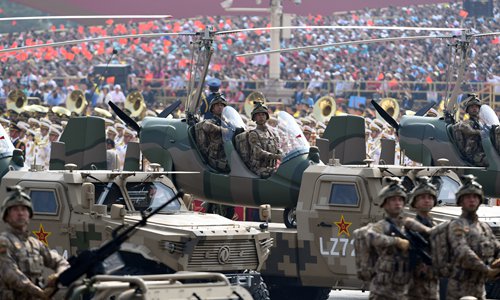HOME >> CHINA
China develops new gyroplane for border plateau operations
By Liu Xuanzun Source:Globaltimes.cn Published: 2020/2/3 0:11:30

A special warfare equipment group formation featuring a type of aerial assault gyroplane marches in a parade to celebrate the 70th anniversary of the founding of the People's Republic of China in Beijing on October 1, 2019. Photo: IC
The latest gyroplane commissioned by the People's Liberation Army (PLA) has increased plateau capabilities for a wider variety of missions and is expected to be deployed along China's southwestern border regions, experts said on Sunday.
Commonly known as the Falcon, the new Lieying gyroplane is equipped with three seats instead of two and has a more powerful engine with 135 horsepower. The gyroplane also has a longer rotor blade that stretches 8.8 meters and redesigned fuel tank, according to Ordnance Industry Science Technology, a Xi'an-based periodical focused on the national defense industry, on Thursday.
Compared with the two-seat model, the three-seat issue has broader military applications as it can carry more personnel and weapons, transport wounded personnel, and conduct missions like two-person parachuting, the report said.
Already proven in earlier tests, the latest model is also capable of operating in plateau areas with heavy loads.
The three-seater can transport up to 630 kilograms and take off, fly, and land at an elevation of 4,200 meters, the magazine reported.
With sledges as landing gears, the gyroplane can take off and land on ice and snow surfaces, the report said, noting that it can also land and take off on water when equipped with floatation gear.
The new Lieying edition is a practical choice for plateau operations in regions like Southwest China's Tibet Autonomous Region, where the two-seat version might struggle, a military expert who asked not to be named told the Global Times on Sunday.
The Falcon is adept at infiltrating hostile areas during stealth reconnaissance missions due to its agility, small size, and low noise output, the expert said.
The Lieying, developed by Shaanxi Bao He Defense Technology, made its PLA debut at China's the National Day parade on October 1, 2019.
Posted in: MILITARY